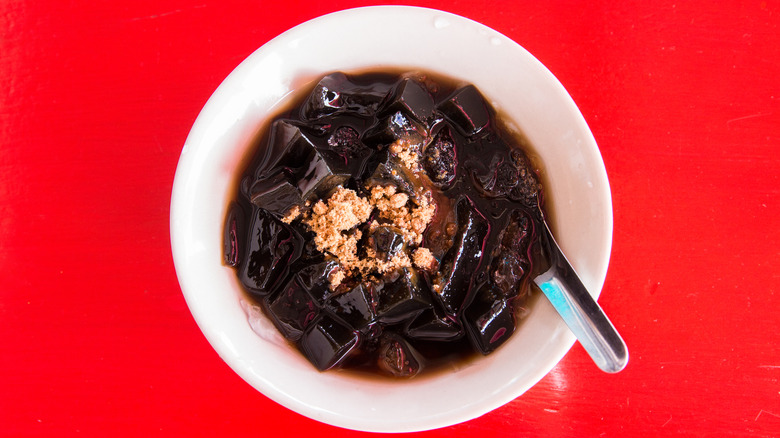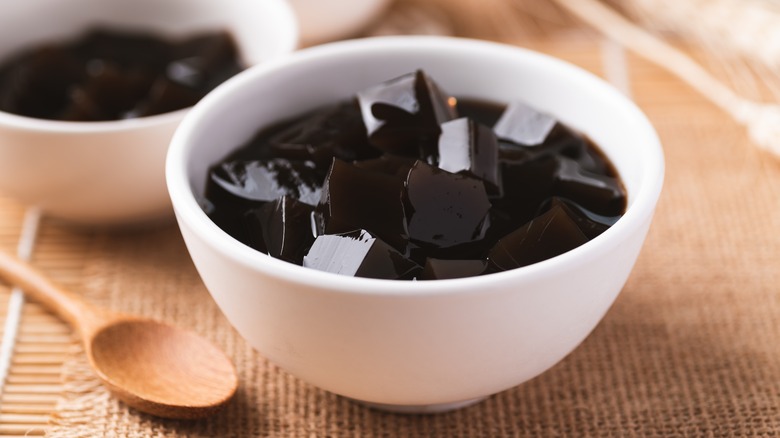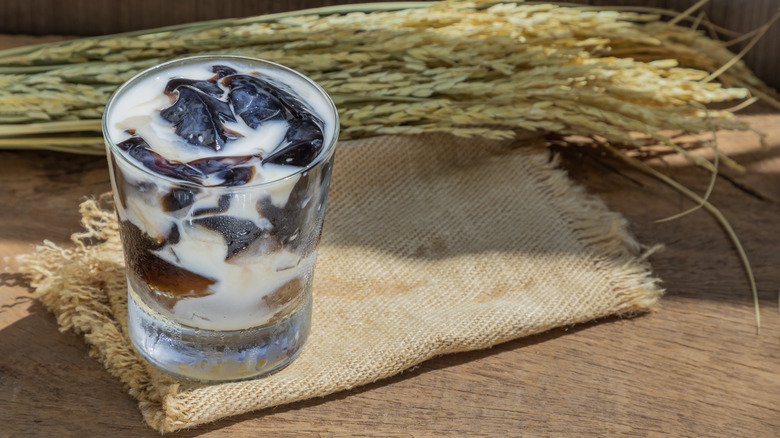Grass Jelly Is A Refreshing Asian Dessert That Comes In A Can
The perfect summer treat should cool you down, like edible air conditioning. Think of ice cream, snow cones, and popsicles. With all of these desserts, 'refreshing' is the operative word, and if the hot weather has you craving such a treat, you ought to sample some grass jelly. This Southeast Asian specialty is particularly popular in China, Taiwan, and Thailand, where it is celebrated for its cooling properties, and it's so unique that there's no other food you can accurately compare it to. In appearance, it broadly resembles jello, minus the vibrant neon colors. Instead, grass jelly is typically dark brown or nearly black, and it has a mild, herbaceous flavor noted for its hints of mint and licorice.
You can find grass jelly in Asian supermarkets around the world, where it typically comes in one of two forms. The most common is canned grass jelly. You pop the top, give it a shake, and the whole mass of jelly plops out, having assumed the cylindrical shape of its container. For uninitiated Americans, the closest comparison would be the canned cranberry sauce popular at Thanksgiving. You can also buy grass jelly in powdered form, which you mix with hot water and allow to cool, similar to the way we prepare jello. If you're lucky, you might be able to find a local Chinese market that sells fresh grass jelly, but it's far less common, especially in the U.S., because it's a laborious food to make.
What exactly is grass jelly?
Grass jelly is made from the Chinese mesona plant, a member of the mint family that is harvested annually in the springtime, right on the cusp of the year's hottest months. To prepare grass jelly, the mesona leaves are dried in the sun until they oxidize, similar to the way tea leaves are prepared. The dried mesona leaves are then boiled for several hours to create a highly concentrated tea of sorts, after which the mixture is strained and often sweetened with sugar or honey. You could drink it just like that, but there's usually one more step. In order to turn the liquid into jiggling jelly, a thickening agent must be added. The traditional choices are arrowroot or cassava root starch, but in modern times corn starch, tapioca starch, gelatin, or agar agar are more common.
Fresh grass jelly has a shelf life of only a week or so, and while the canned and powdered versions last much longer, they do incorporate additives and sometimes come at the expense of flavor. While canned grass jelly is refreshingly cool, it is generally described as having very little flavor aside from the sweetness of the added honey or sugar, and a slight hint of grassy, herbaceousness in the background. Freshly-prepared grass jelly, on the other hand, is quite aromatic, and its flavor profile even has a slight smokiness. Texture-wise, it is springier than canned grass jelly, and its color leans towards golden brown rather than black.
How to eat grass jelly
Grass jelly is a very versatile product, so there's quite a lot you can do with it. One of the most straightforward preparations is to plate up some grass jelly and top it with taro balls or sweet red beans. If you really need to beat back the summer heat, you can try it over shaved ice or ice cream. Grass jelly is also a popular addition to various beverages. You can have it with milk, juice, or tea, where it plays a similar role to the boba balls in bubble tea. There are even brands of grass jelly soft drinks that you can find at many Asian markets. To double down on your Chinese mesona experience, you can buy liquid grass jelly (that's the thick tea that exists before the thickening agent is added) and mix in chunks of the jellified version.
All of these preparation styles would look a bit strange to the people who first invented grass jelly, however. It was originally prepared by the Hakka people, a subgroup of the Han Chinese who settled in southern China around the 13th century. The Hakka used grass jelly to fight off the danger of heat stroke during hot and humid days of fieldwork. In this initial form, grass jelly was used for the benefit of one's health, with flavor being an afterthought. Therefore, the grass jelly first prepared by the Hakka was not sweetened or mixed with any of the flavorful additions it typically is today.


